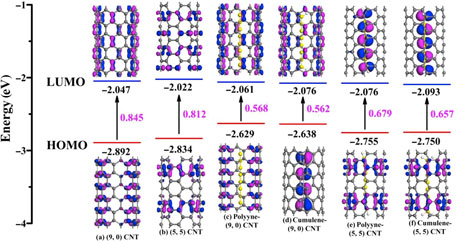Crossref Citations
This article has been cited by the following publications. This list is generated based on data provided by
Crossref.
Xiao, Song
Zhang, Jun
Zhang, Xiaoxing
and
Cui, Hao
2018.
Pt-doped single-walled CNT as a superior media for evaluating the operation status of insulation devices: A first-principle study.
AIP Advances,
Vol. 8,
Issue. 10,
Wan, Qianqian
Xu, Yancheng
and
Xiao, Hanyan
2018.
Exhaled gas detection by Ir-doped CNT for primary diagnosis of lung cancer.
AIP Advances,
Vol. 8,
Issue. 10,
Cui, Hao
Zhang, Xiaoxing
and
Chen, Dachang
2018.
Borophene: a promising adsorbent material with strong ability and capacity for SO2 adsorption.
Applied Physics A,
Vol. 124,
Issue. 9,
Zhang, Yongze
Sun, Xiao
Tan, Shi
Liu, Tun
and
Cui, Hao
2019.
Adsorption characteristic of Rh-doped MoSe2 monolayer towards H2 and C2H2 for DGA in transformer oil based on DFT method.
Applied Surface Science,
Vol. 487,
Issue. ,
p.
930.
Zhu, Shiyuan
and
Ma, Shouxiao
2019.
Adsorption and Sensing Behaviors of Pd-Doped InN Monolayer upon CO and NO Molecules: A First-Principles Study.
Applied Sciences,
Vol. 9,
Issue. 16,
p.
3390.
Ma, Shouxiao
Su, Liancun
Jin, Li
Su, Jinsheng
and
Jin, Ying
2019.
A first-principles insight into Pd-doped MoSe2 monolayer: A toxic gas scavenger.
Physics Letters A,
Vol. 383,
Issue. 30,
p.
125868.
Cui, Hao
Zhang, Xiaoxing
Li, Yi
Chen, Dachang
and
Zhang, Ying
2019.
First-principles insight into Ni-doped InN monolayer as a noxious gases scavenger.
Applied Surface Science,
Vol. 494,
Issue. ,
p.
859.
Cui, Hao
Zhang, Guozhi
Zhang, Xiaoxing
and
Tang, Ju
2019.
Rh-doped MoSe2 as a toxic gas scavenger: a first-principles study.
Nanoscale Advances,
Vol. 1,
Issue. 2,
p.
772.
Cui, Hao
Chen, Dachang
Zhang, Ying
and
Zhang, Xiaoxing
2019.
Dissolved gas analysis in transformer oil using Pd catalyst decorated MoSe2 monolayer: A first-principles theory.
Sustainable Materials and Technologies,
Vol. 20,
Issue. ,
p.
e00094.
Yan, Chao
Zeng, Qunfeng
and
Zhu, Jianing
2019.
Ag-doping behavior on (8, 0) single-walled carbon nanotube with single C-vacancy or pyridine-like N3 defect: a DFT study.
Carbon Letters,
Vol. 29,
Issue. 6,
p.
625.
Cui, Hao
Liu, Tun
Zhang, Ying
and
Zhang, Xiaoxing
2019.
Ru-InN Monolayer as a Gas Scavenger to Guard the Operation Status of SF6 Insulation Devices: A First-Principles Theory.
IEEE Sensors Journal,
Vol. 19,
Issue. 13,
p.
5249.
Cui, Hao
Chen, Dachang
Yan, Chao
Zhang, Ying
and
Zhang, Xiaoxing
2019.
Repairing the N-vacancy in an InN monolayer using NO molecules: a first-principles study.
Nanoscale Advances,
Vol. 1,
Issue. 5,
p.
2003.
Bolivar-Pineda, Lina M.
and
Basiuk, Vladimir A.
2020.
Interactions of metal phthalocyanines with Stone-Wales defects on single-walled carbon nanotubes: A theoretical study.
Journal of Applied Physics,
Vol. 127,
Issue. 2,
Atsbeha Kahsay, Berhanemeskel
Wang, Fu-Ming
Hailu, Alem Gebrelibanos
and
Su, Chia-Hung
2020.
Maleamic Acid as an Organic Anode Material in Lithium-Ion Batteries.
Polymers,
Vol. 12,
Issue. 5,
p.
1109.
Berdiyorov, G.R.
Eshonqulov, G.
and
Hamoudi, H.
2020.
Electronic transport of CNT-encapsulated carbyne.
Computational Materials Science,
Vol. 183,
Issue. ,
p.
109809.
Yu, Yuanyuan
and
Dai, Chunfeng
2021.
DFT study of gas adsorption and sensing based on noble metal (Ag, Au and Pt) functionalized boron selenide nanosheets.
Physica E: Low-dimensional Systems and Nanostructures,
Vol. 125,
Issue. ,
p.
114409.
Lin, Long
Feng, Zhiyan
Dong, Zhongzhou
Chen, Zehua
Tao, Hualong
Hu, Chencheng
and
Han, Linhao
2022.
Adsorption of small gas molecules of transition metal (Pt and Au) modified HfSe2 monolayer.
Materials Today Communications,
Vol. 32,
Issue. ,
p.
103885.
Zhang, Bing
Li, Xinchun
Xie, Kun
Hu, Chencheng
Wang, Dongbin
Lin, Long
and
Gao, Jiajia
2024.
Adsorption of SF6 decomposition gases (SO2 and SOF2) onto pristine and transition metal modified WSe2 monolayers: A systematic DFT study.
Computational Materials Science,
Vol. 244,
Issue. ,
p.
113181.
Tasleem, Mohammad
Ahmad, Ikrar
and
Sankar, Muniappan
2025.
Porphyrin‐Based Covalent Organic Polymer Wrapped MWCNT Electrodes under Moderate Salt Concentration for Super‐Stable Aqueous Sodium‐Ion Intercalated Sustainable Supercapacitor.
Small,
Vol. 21,
Issue. 7,



